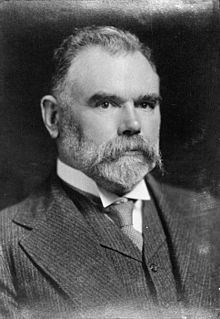Spouse(s) Ida Henrietta Nantes Resigned July 10, 1912 | Name Thomas Mackenzie Children Clutha Mackenzie | |
 | ||
Born 10 March 1853Edinburgh, Scotland ( 1853-03-10 ) Previous office Prime Minister of New Zealand (1912–1912) | ||
I m the butcher would you like some beef thomas mackenzie michele orru at 44con 2012
Sir Thomas Mackenzie (10 March 1853 – 14 February 1930) was a Scottish-born New Zealand politician and explorer who briefly served as the 18th Prime Minister of New Zealand in 1912, and later served as New Zealand High Commissioner in London.
Contents
- I m the butcher would you like some beef thomas mackenzie michele orru at 44con 2012
- Early years
- Member of Parliament
- Minister and Prime Minister
- Later years
- References

Early years
Mackenzie was born in Edinburgh. His family emigrated to New Zealand in 1858 when he was four and Mackenzie was educated at Green Island School and at the Stone School, both in Dunedin. He tried his hand at surveying, farming and commerce.
Member of Parliament
Mackenzie was elected to the New Zealand Parliament for Clutha in 1887. He resigned in 1896 to assess the British markets for New Zealand products and remained in his native land for three years. On his return to New Zealand he was elected to Parliament successively for Waihemo 1900–1902, Waikouaiti 1902–1908, Taieri 1908–1911 and Egmont (in the North Island) 1911–1912, never losing an election.
Mackenzie was also a notable explorer. He was a member of expeditions to the Tautuku Forest (1883), the wild country between Milford Sound and Lake Te Anau (1888; discovered the Sutherland Falls), and the Matterhorn Mountains (1888; discovered a pass between Lake Manapouri and Hall Arm). He was the first person to try to map an overland route to Dusky Sound (1894–1896). He crossed the land between Lake Te Anau and Lake Wakatipu in 1907.
Minister and Prime Minister
In January 1909 he was appointed Minister of Industries and Commerce, Tourist and Health Resorts, Scenery Preservation and State Forestry Departments in the government of Sir Joseph Ward. In May he also became Minister of Agriculture with a seat in the Cabinet. He was then successively Minister of Customs, Minister of Education and Postmaster-General. In May 1912 he succeeded Ward as Prime Minister and also served as Minister of Lands.
Mackenzie's Ministry was criticised by both the opposition and Liberal dissidents. Liberal MP Roderick McKenzie stated that Mackenzie's ministers were political novices who had forsaken their liberal principles and John Millar should have been Ward's successor as Prime Minister.
The Mackenzie government survived only until July 1912 when he lost a vote of no confidence and was appointed High Commissioner in London. He served in this role until 1920 and was New Zealand delegate at the peace conferences with Austria, Bulgaria and Turkey in 1919, a member of the Dardanelles Commission and the Imperial War Graves Commission (later the Commonwealth War Graves Conmmission). In March 1921 he was appointed member of the New Zealand Legislative Council for Otago.
Later years
He was appointed Knight Commander of the Order of St Michael and St George (KCMG) in the 1916 New Year Honours and promoted to Knight Grand Cross (GCMG) in June 1920.
His son Clutha Mackenzie who was blinded at Gallipoli was active in work for the blind. In 1923 he supported Val Sanderson in establishing the Native Bird Protection Society (later the Royal Forest and Bird Protection Society of New Zealand) and was the society's first president.
Mackenzie died in Dunedin in 1930 and was buried in the Dunedin Northern Cemetery.
